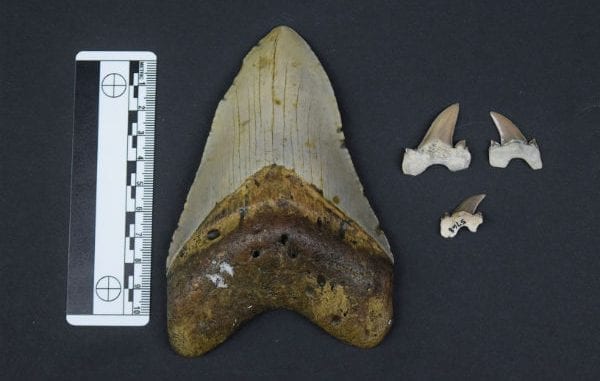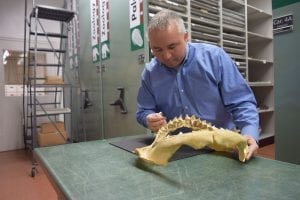
Scientists have reason to believe that the local discovery of a new species of mega-toothed shark, which has been named Bryant Shark and was uncovered in Central Alabama, could have been part of the lineage that eventually led to Megalodon.
Published: January 19, 2018
By: Courtesy of McWane Science Center
Author Website: Click to Visit

Scientists have recently announced the discovery of a new species of fossil “mega-toothed” shark from Alabama, named Cretalamna bryanti. Lead scientist in this study, Jun Ebersole, Director of Collections at McWane Science Center in Birmingham, AL said “this shark lived during the time of the dinosaurs in the Late Cretaceous Period, roughly 83 million years ago.”
Nicknamed the “Bryant Shark”, this new species was named in honor of the Bryant family, the patriarch of which was the late University of Alabama football coach, Paul “Bear” Bryant. According to Ebersole, “the members of the Bryant family have been long time supporters of not only McWane Science Center, but also the Alabama Museum of Natural History in Tuscaloosa and the University of Alabama. This new species honors the Bryant family’s long-standing commitment to education in our state.”
This new shark species was named from roughly 30 teeth which were discovered in dinosaur-aged rocks in central Alabama. The fossil Bryant Shark teeth were collected over the course of 40 years and were identified in the scientific collections at McWane Science Center in Birmingham, AL and the Alabama Museum of Natural History in Tuscaloosa.
According to Ebersole “for years this new species had been overlooked, not recognized, or misidentified by previous scientists as other shark species. The recognition of this new species lends further evidence the diversity of early mega-toothed sharks was much higher during the Late Cretaceous than previously thought.”
The largest discovered teeth measure a little over one inch in height. “The teeth of the Bryant Shark are very similar to several mega-tooth shark species which survived the extinction of the dinosaurs” said Ebersole. “Although it is not conclusive, this suggests the Bryant Shark may be part of the direct lineage which eventually led to Megalodon.”
The Bryant Shark is an ancient member of the Otodontids, or mega-toothed sharks, an extinct family who evolved over 100 million years ago and includes the largest predatory shark who ever lived, the 60-foot Megalodon. These sharks are called “mega-toothed” due to the size of their teeth.
The study, titled “A new species of Cretalamna sensu stricto (Lamniformes, Otodontidae) from the Late Cretaceous (Santonian-Campanian) of Alabama, USA” was recently published in the online open-access science journal PeerJ (http://www.peerj.com). Several teeth from the Bryant Shark will soon be on display in the fossil hall at McWane Science Center.
About McWane Science Center
McWane Science Center is a nonprofit, hands-on discovery museum and IMAX Dome Theater. Designed to inspire a life- long love of learning, McWane Science Center has welcomed millions of visitors since opening its doors in 1998. With four floors of interactive exhibits, McWane has an extensive lineup of science demonstrations performed daily by award-winning educators. Explorers of all ages flock year-round to see, to hear, to touch and to experience the wonder of science in one of the South’s most unique venues. For more information, visit http://www.mcwane.org.
